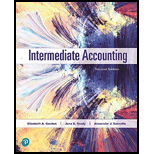
Intermediate Accounting (2nd Edition)
2nd Edition
ISBN: 9780134730370
Author: Elizabeth A. Gordon, Jana S. Raedy, Alexander J. Sannella
Publisher: PEARSON
expand_more
expand_more
format_list_bulleted
Textbook Question
Chapter 2, Problem 2.15BE
Element Definitions. Identify whether the following definitions rotate to assets, liabilities or equity.
| Element | Definition |
| _____________ | Probable future sacrifices of economic benefits arising from present obligations of a particular entity to transfer assets or provide services to other entities in the future as a result of past transactions or events. |
| _____________ | The net assets are the residual interest in the assets of an entity that remains after deducting ns liabilities. |
| _____________ | Probable future economic benefits will be obtained or controlled by a particular entity as a result of past transactions or events. |
Expert Solution & Answer
Trending nowThis is a popular solution!

Students have asked these similar questions
I need help solving this general accounting question with the proper methodology.
Please help me solve this general accounting problem with the correct financial process.
I need help with this general accounting problem using proper accounting guidelines.
Chapter 2 Solutions
Intermediate Accounting (2nd Edition)
Ch. 2 - Prob. 2.1QCh. 2 - Prob. 2.2QCh. 2 - Why is a conceptual framework of accounting...Ch. 2 - Prob. 2.4QCh. 2 - Prob. 2.5QCh. 2 - Prob. 2.6QCh. 2 - Prob. 2.7QCh. 2 - What is predictive value?Ch. 2 - Prob. 2.9QCh. 2 - When is financial information considered...
Ch. 2 - Prob. 2.11QCh. 2 - Prob. 2.12QCh. 2 - Prob. 2.13QCh. 2 - What is the recognition principle and when is an...Ch. 2 - What is the revenue recognition principle and when...Ch. 2 - Prob. 2.16QCh. 2 - When are expenses recognized under IFRS?Ch. 2 - How are transactions recorded under accrual...Ch. 2 - Prob. 2.19QCh. 2 - Prob. 2.20QCh. 2 - Prob. 2.1BECh. 2 - Prob. 2.2BECh. 2 - Objective of Financial Reporting. Explain the...Ch. 2 - Prob. 2.4BECh. 2 - Fundamental and Enhancing Characteristics....Ch. 2 - Prob. 2.6BECh. 2 - Prob. 2.7BECh. 2 - Prob. 2.8BECh. 2 - Fundamental and Enhancing Characteristics....Ch. 2 - Faithful Representation. Match the component of a...Ch. 2 - Prob. 2.11BECh. 2 - Prob. 2.12BECh. 2 - Capital Maintenance Adjustments, IFRS. Describe...Ch. 2 - Expense Recognition. Discuss the three main...Ch. 2 - Element Definitions. Identify whether the...Ch. 2 - Prob. 2.16BECh. 2 - Element Definitions, U.S. GAAP, IFRS. Identify...Ch. 2 - Prob. 2.18BECh. 2 - Measurement Bases. Match the measurement basis...Ch. 2 - Cash versus Accrual Bases of Accounting. The...Ch. 2 - Assumptions in Financial Reporting. Indicate the...Ch. 2 - Conceptual Framework. Noeleen Auto Mall, Ltd....Ch. 2 - Qualitative Characteristics. Referring to the...Ch. 2 - Prob. 2.3ECh. 2 - Prob. 2.4ECh. 2 - Terms and Concepts. Complete the following...Ch. 2 - Prob. 2.6ECh. 2 - Cash versus Accrual Bases of Accounting. Top Notch...Ch. 2 - Cash vs. Accrual. you are provided the following...
Knowledge Booster
Learn more about
Need a deep-dive on the concept behind this application? Look no further. Learn more about this topic, accounting and related others by exploring similar questions and additional content below.Similar questions
- Can you explain the correct approach to solve this general accounting question?arrow_forwardWilson Manufacturing reported annual sales revenue of $4,250,000. During the year, accounts receivable decreased from a $95,000 beginning balance to a $75,000 ending balance. Accounts payable increased from a $60,000 beginning balance to a $90,000 ending balance. How much is cash received from customers for the year?arrow_forwardPlease provide the answer to this general accounting question using the right approach.arrow_forward
- Add more info and expand upon this, why, some of the things touch in the sentences the case.arrow_forwardCan you help me solve this general accounting question using the correct accounting procedures?arrow_forwardPlease help me solve this general accounting problem with the correct financial process.arrow_forward
- Subject = General Accountarrow_forwardAccounting?arrow_forwardDriftwood Furniture Company implemented a new quality control system. Product approval requires: material inspection (40% weighting), structural testing (30% weighting), and finish quality (30% weighting). If a product scored 76 on material inspection, 82 on structural testing, and 68 on finish quality, your task is to identify the weighted quality score.arrow_forward
arrow_back_ios
SEE MORE QUESTIONS
arrow_forward_ios
Recommended textbooks for you
- Principles of Accounting Volume 1AccountingISBN:9781947172685Author:OpenStaxPublisher:OpenStax College



Principles of Accounting Volume 1
Accounting
ISBN:9781947172685
Author:OpenStax
Publisher:OpenStax College
What is Fund Accounting?; Author: Aplos;https://www.youtube.com/watch?v=W5D5Dr0j9j4;License: Standard Youtube License